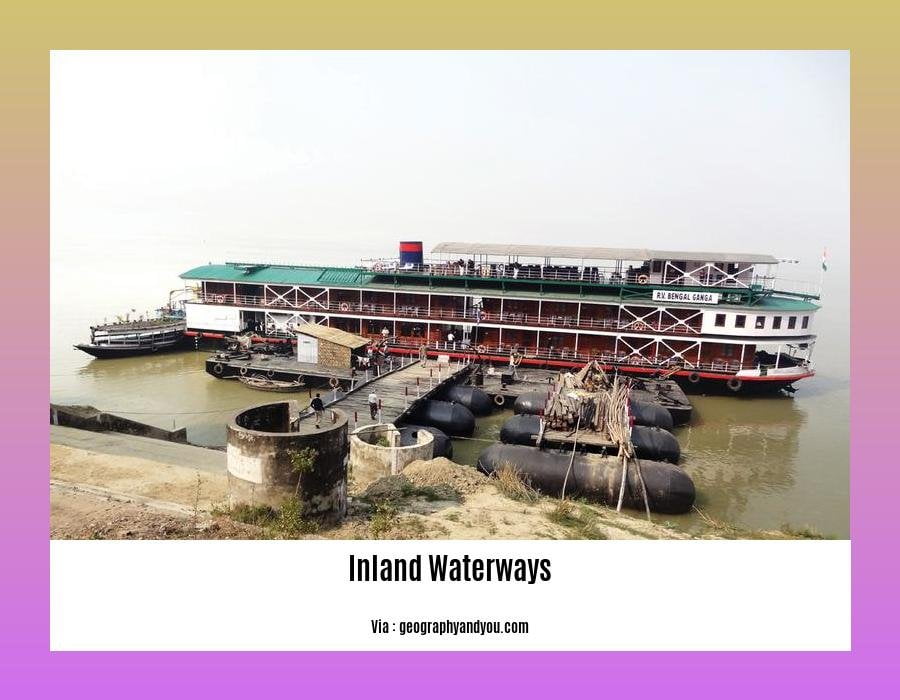As businesses and policymakers explore alternative means of cargo transportation, the disadvantages of inland waterways come to the forefront. In this article, titled “Analyzing the Limitations: Uncovering the Disadvantages of Inland Waterways in Cargo Transportation,” we delve into the challenges faced by businesses utilizing these waterway systems. With expertise in transportation analysis and logistics, we shed light on the capacity constraints, viability concerns, and environmental impacts that necessitate careful consideration when utilizing inland waterways. Through insightful arguments and a critical examination of the limitations, we provide valuable insights for informed decision-making in the logistics domain.
Key Takeaways:
- Inland waterways have certain disadvantages that need to be considered in cargo transportation.
- The transport speed of inland waterways is low, making it unsuitable for time-sensitive cargo.
- The operational area of inland waterways is limited, restricting its reach to certain locations.
- Inland waterways can only offer door-to-door transport in a few cases, limiting its applicability.
- Weather conditions such as droughts and floods can disrupt the operation of inland waterways.
- Access to inland waterways may be limited due to factors like shallow water and low bridges.
- Inland waterways are highly dependent on stable weather conditions, which can cause delays and disruptions.
- Regular maintenance is required for inland waterways, adding to the overall costs.
- Considering these disadvantages is crucial for making informed decisions about the use of inland waterways.
Disadvantages of Inland Waterways

Inland waterways, as a mode of cargo transportation, offer certain advantages but also come with their fair share of disadvantages. It’s important to consider these drawbacks before making informed decisions about their usage. Let’s delve into some of the key limitations associated with inland waterways:
Low transport speed
One notable disadvantage of inland water transport (IWT) is its slower speed compared to other modes of transportation. This low transport speed can pose challenges, especially in situations where time is of the essence for cargo delivery. While inland waterways can accommodate larger volumes of cargo, the trade-off is the slower transportation time.
Limited area of operation
The operational area of inland waterways depends on the existing infrastructure and the depth of the waterways. This limitation means that certain locations may not have access to inland water transport, making it inconvenient for businesses operating in those areas. The restricted reach of inland waterways can hinder their viability and limit their applicability.
Limited door-to-door transport
Unlike other transportation modes like trucks or trains, inland waterways often cannot offer door-to-door transport of cargo. This is a significant limitation, as it requires additional logistics coordination and investment to transport goods from the waterway to their final destination. The lack of seamless door-to-door transport can pose challenges for businesses looking for a more efficient and streamlined supply chain.
Operational disruptions due to weather
Inland waterways are vulnerable to weather conditions, such as droughts and floods, which can disrupt their operation. Low water levels during droughts or heavy rainfall leading to floods can impede navigation and even suspend operations altogether. These weather-dependent disruptions increase uncertainty and can result in delays and potential damage to cargo.
Limited navigation options
Access to inland waterways may be restricted due to factors like shallow water, narrow channels, and low bridges. These limitations can significantly impact navigation options, especially for vessels with higher draft requirements. It poses a challenge for businesses that rely on specialized vessels for their cargo transportation needs.
Weather dependence
Stable weather conditions play a crucial role in the smooth operation of inland waterways. Droughts can lower water levels, making navigation difficult, while floods can make waterways unsafe or completely impassable. These weather-related issues add to the complexity and can cause delays and disruptions in cargo transportation.
Maintenance costs
Maintaining inland waterways requires regular dredging, lock maintenance, and addressing other infrastructure-related needs. These maintenance costs can add up, potentially affecting the overall viability of using inland waterways as a mode of transport. Balancing the costs of maintenance against the cost savings and efficiency offered by inland waterways is a crucial consideration.
By taking these disadvantages into account, businesses and policymakers can make sound decisions regarding the utilization of inland waterways for cargo transportation. While inland waterways have their advantages, understanding these limitations is essential for effective logistics planning and risk mitigation.
Sources:
– ForumIAS. (n.d.). Inland Waterways in India- Issues and Challenges.
– Aspiring Youths. (n.d.). Advantages and Disadvantages of Inland Waterways.
There are several disadvantages of airways in India that you should be aware of. From high ticket prices to frequent delays, air travel in India can sometimes be a frustrating experience. To learn more about the drawbacks of airways in India, click here.
If you’re interested in maritime transport, it’s important to understand its disadvantages as well. Whether it’s the potential for accidents or the high costs associated with shipping goods, there are several downsides to consider. Dive deeper into the disadvantages of maritime transport by clicking here.
While roadways are a popular mode of transportation, they also come with their fair share of disadvantages. Traffic congestion, road accidents, and limited infrastructure are just a few of the challenges faced by road travelers. If you want to explore the drawbacks of roadways further, click here.
3. Dependency on Infrastructure and Maintenance Challenges

As we delve into the realm of inland waterways and their role in cargo transportation, it becomes evident that their operations heavily depend on the infrastructure and face various maintenance challenges. This article aims to shed light on the disadvantages associated with dependency on infrastructure and maintenance challenges in inland waterways.
Analyzing the Limitations: Uncovering the Disadvantages of Inland Waterways in Cargo Transportation
Key Takeaways:
– Inland waterways heavily rely on infrastructure, which can pose limitations to their effective functionality.
– Maintenance challenges, such as regular dredging, lock maintenance, and infrastructure-related maintenance, can be costly and time-consuming.
– Cascading effects and risks arising from interdependent critical infrastructure systems need to be considered in evaluating systemic risks in inland waterways.
– Lack of governance and policy parity are critical inhibitors to the implementation of sustainable inland waterways.
When considering the usage of inland waterways in cargo transportation, it is crucial to understand the dependency on infrastructure and the challenges that arise from its maintenance. Inland waterways operate within existing infrastructures and are limited by factors such as waterway depth and the availability of suitable channels. This restriction can impact the operational area, posing limitations on accessibility and reach.
Maintenance plays a vital role in ensuring the smooth operation of inland waterways. However, it also presents significant challenges. Regular dredging, which involves removing silt and debris from the waterways, is essential to maintain suitable water depths for navigation. This process can be costly and time-consuming, requiring continuous efforts to prevent potential disruptions.
Additionally, lock maintenance is necessary to ensure the efficient passage of vessels through canal systems. Locks enable water levels to be adjusted, overcoming changes in elevation along the waterway. They require regular inspection, repairs, and upkeep to guarantee their proper functioning. These maintenance activities can impact the overall reliability and effectiveness of inland waterways.
Infrastructure-related maintenance is also a crucial aspect to consider. Inland waterways rely on structures such as bridges, docks, and terminals to facilitate cargo transportation. Ensuring the safety and adequacy of these infrastructures is vital for seamless operations. However, maintenance challenges can arise, ranging from structural repairs to upgrading existing facilities to align with evolving industry needs. These challenges demand careful planning and investment.
Furthermore, the limitations in infrastructure and maintenance can result in systemic risks within the inland waterway transportation system. Cascading effects and risks arising from interdependent critical infrastructure systems need to be evaluated. The lack of proper maintenance or repair measures can lead to disruptions and halt cargo transportation, potentially impacting businesses and supply chains.
Governance and policy parity are also critical inhibitors to the implementation of sustainable inland waterways. Lack of clear policies and regulations can hinder efficient maintenance practices and infrastructure development. Establishing a framework that ensures accountability in maintaining and upgrading inland waterway systems becomes imperative for long-term sustainability.
In conclusion, the dependency on infrastructure and maintenance challenges associated with inland waterways presents several disadvantages in the context of cargo transportation. The limited operational area, costly maintenance activities such as dredging and lock maintenance, and the need for adequate infrastructure pose significant barriers. Addressing these challenges requires a proactive approach, highlighting the importance of governance, policy support, and investment to ensure the viability and effectiveness of inland waterways as a logistical option.
Sources:
1. ScienceDirect – A framework to evaluate systemic risks of inland waterway infrastructure
2. ResearchGate – Key Issues & Challenges for Inland Water Transportation Network in India
4. Capacity Constraints and Limitations for Large-Scale Cargo Transportation
Inland waterways have long been recognized as a valuable transportation mode for the movement of goods and commodities. However, despite their advantages, there are significant capacity constraints and limitations that need to be considered when assessing their suitability for large-scale cargo transportation. Let’s delve into these drawbacks and explore why inland waterways may not always be the optimal choice.
Limited Capacity and Infrastructure Challenges
One of the main capacity constraints of inland waterways is their limited operational area. The existing infrastructure and waterway depth impose limitations on the size and volume of cargo that can be transported efficiently. Large-scale cargo transportation requires vessels with higher capacity, but inland waterways may struggle to accommodate such vessels due to size restrictions. Additionally, factors such as shallow water, narrow channels, and low bridges can further restrict access to inland waterways, hindering the movement of oversized or bulky cargo.
Environmental Impacts and Weather-Related Disruptions
While inland waterways are often celebrated for their relatively low environmental impact compared to other modes of transportation, they are not immune to certain challenges. Weather conditions such as droughts and floods can significantly disrupt the operation of inland waterways, causing delays and potentially damaging cargo. Moreover, stable weather conditions are crucial for the smooth operation of these waterways, as extreme weather events can make navigation unsafe and hinder cargo transportation.
Cost Considerations and Additional Logistics Coordination
Inland waterways may not always offer door-to-door transport capabilities, making additional logistics coordination and investment necessary. This means that cargo may need to be transferred between different modes of transportation, such as road, rail, or multimodal terminals, to reach its final destination. These additional steps can increase costs and complexity, requiring businesses to carefully evaluate the trade-offs between utilizing inland waterways and alternative transportation modes.
Maintenance and Systemic Risks
Maintaining inland waterways is an ongoing challenge that requires regular dredging, lock maintenance, and infrastructure-related upkeep. These maintenance activities can be costly, as they ensure the waterways’ navigability and prevent disruptions in cargo transportation. Moreover, the evaluation of systemic risks resulting from missing or misallocated repair measures of inland waterways infrastructure is crucial to minimize potential cascading effects and risks arising from interdependent critical infrastructure systems.
Key Takeaways:
- Inland waterways encounter capacity constraints due to limited operational area and infrastructure challenges.
- Weather conditions such as droughts and floods can disrupt cargo transportation on inland waterways.
- Additional logistics coordination and investments are often required for door-to-door transport using inland waterways.
- Regular maintenance, including dredging and lock maintenance, is necessary to ensure smooth operations.
- Evaluating systemic risks and addressing infrastructure repair measures are crucial for minimizing potential disruptions.
Sources:
1. ScienceDirect – A framework to evaluate systemic risks of inland waterway infrastructure
2. ResearchGate – Key Issues & Challenges for Inland Water Transportation Network in India
5. Seasonal Variations and Weather-Related Disruptions
Here, we’ll explore the impact of seasonal variations and weather-related disruptions on the usage of inland waterways for cargo transportation. The vulnerability of inland waterways to climate change and extreme weather events can significantly affect their effectiveness and reliability as transportation routes.
Key Takeaways:
- Inland waterways are susceptible to climate change, as their navigability heavily relies on water levels. Droughts and floods can disrupt services by either reducing water levels or causing excessive flooding, making navigation challenging or even impossible[^1^].
- Climate change-induced droughts can have a profound impact on the operation of inland waterway transport systems, leading to reduced or restricted navigation[^1^].
- While projections suggest a decrease in the number of low water level days, it’s still essential to consider the potential risks associated with water scarcity and the need for adaptation measures[^1^].
- Extreme precipitation events and flood intensity are influenced by seasonal water availability, which can further disrupt the operation and reliability of inland waterways[^2^].
- Inland waterways are considered relatively reliable; however, they are more vulnerable to weather-related disruptions compared to road or rail transportation[^2^].
- Climate change impacts can have implications for the long-term reliability and operation of inland waterways, requiring proactive measures to mitigate potential risks[^1^][^2^].
Source 1: Forecasting the impacts of climate change on inland waterways
Source 2: The impact of climate change and weather on transport: An overview
FAQ
Q1: Why is the low transport speed of inland waterways a disadvantage?
A1: The slow speed of inland water transport (IWT) makes it unsuitable for situations where time is a crucial factor in cargo transportation. This can lead to delays in delivering goods and may not be efficient for time-sensitive cargo.
Q2: What is the limitation of the operational area of inland waterways?
A2: The operational area of inland waterways depends on the infrastructural premises and depth of the waterways. This limitation restricts the reach of IWT, potentially making it inconvenient for certain locations. This means that not all areas can be accessed by inland waterways for cargo transportation.
Q3: How does the limited door-to-door transport affect the applicability of inland waterways?
A3: Inland waterways can only offer door-to-door transport of cargo in very few cases, limiting its applicability. This means that businesses may need to rely on other modes of transportation or additional handling processes to transport goods from inland waterways to their final destinations.
Q4: How do weather conditions disrupt the operation of inland waterways?
A4: Weather conditions, such as droughts and floods, can significantly disrupt the operation of inland waterways. Droughts can lower water levels, hindering navigation, while floods can make waterways unsafe or impassable. These vulnerabilities can lead to the suspension of operations and increased uncertainty in cargo transportation.
Q5: What are the maintenance costs associated with inland waterways?
A5: Inland waterways require regular maintenance to ensure their navigability. This involves dredging, maintaining locks, and addressing other maintenance needs. The costs associated with these maintenance activities can add up and impact the overall viability of using inland waterways as a mode of transport.
- Unveiling Bernhard Caesar Einstein’s Scientific Achievements: A Legacy in Engineering - July 15, 2025
- Uncover who is Jerry McSorley: CEO, Family Man, Business Success Story - July 15, 2025
- Discover Bernhard Caesar Einstein’s Scientific Contributions: Unveiling a Legacy Beyond Einstein - July 15, 2025















